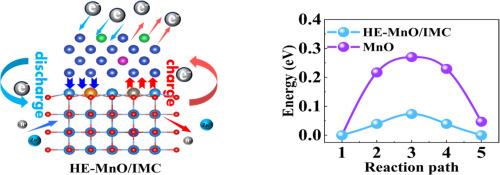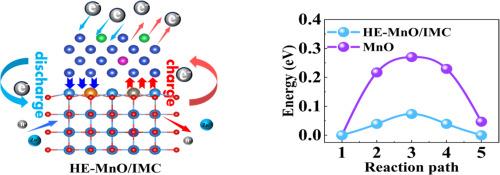Boosting Zn2+ intercalation via high-entropy doping and dynamic electron reservoirs for high-performance Zn-Mn batteries
IF 9.3
1区 材料科学
Q1 MATERIALS SCIENCE, MULTIDISCIPLINARY
引用次数: 0
Abstract
Among manganese oxides, MnO with the highest theoretical capacity holds promise for ultra-high energy density Zn-ion batteries but is restricted ion/electron migration. Here, we synthesized a carbon-coated, high-entropy-doped MnO and intermetallic compounds (IMC) heterostructure (HE-MnO/IMC) by integrating high-entropy doping and heterojunction strategies to address intrinsic challenges. Carbon coating with abundant C = O bonds externally provides a rapid transport pathway for Zn2+. High-entropy doped MnO internally optimizes Zn2+ migration via lattice distortion, while IMC optimizes electron transfer through interfacial effects and maintains charge balance as a dynamic electron reservoir. This integrated design strategy of complex structures and synergistic effects facilitates efficient ion and electron transport, achieving excellent rate performance (136.4 mAh g-1 at 5.0 A g-1) and stability (90.9% retention after 10,000 cycles). This work provides a new paradigm for the precise regulation of the reactive kinetic behaviour of functional materials.


高性能锌锰电池中高熵掺杂和动态电子库促进Zn2+嵌入
在锰氧化物中,理论容量最高的MnO有望用于超高能量密度的锌离子电池,但其离子/电子迁移受到限制。本文通过整合高熵掺杂和异质结策略,合成了碳包覆、高熵掺杂的MnO和金属间化合物(IMC)异质结构(HE-MnO/IMC)。碳涂层具有丰富的C=O键,为Zn2+提供了快速的输运途径。高熵掺杂MnO内部通过晶格畸变优化Zn2+迁移,而IMC通过界面效应优化电子转移,并作为动态电子储存库保持电荷平衡。这种复杂结构和协同效应的集成设计策略促进了高效的离子和电子传输,实现了优异的倍率性能(在5.0 A g-1时136.4 mAh g-1)和稳定性(10,000次循环后保持90.9%)。这项工作为功能材料反应动力学行为的精确调控提供了一个新的范例。
本文章由计算机程序翻译,如有差异,请以英文原文为准。
求助全文
约1分钟内获得全文
求助全文
来源期刊

Acta Materialia
工程技术-材料科学:综合
CiteScore
16.10
自引率
8.50%
发文量
801
审稿时长
53 days
期刊介绍:
Acta Materialia serves as a platform for publishing full-length, original papers and commissioned overviews that contribute to a profound understanding of the correlation between the processing, structure, and properties of inorganic materials. The journal seeks papers with high impact potential or those that significantly propel the field forward. The scope includes the atomic and molecular arrangements, chemical and electronic structures, and microstructure of materials, focusing on their mechanical or functional behavior across all length scales, including nanostructures.
 求助内容:
求助内容: 应助结果提醒方式:
应助结果提醒方式:


